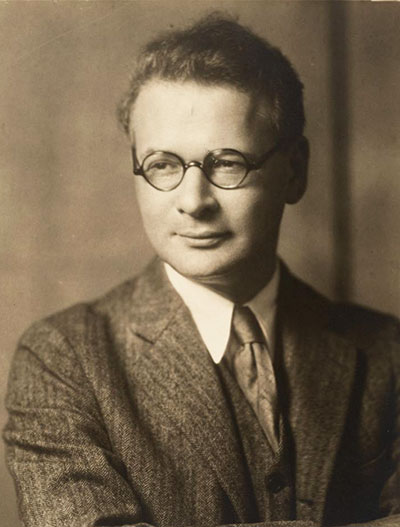America’s Jewish Bridegroom
Horace Kallen can be found in the ill-starred pantheon of prolific writers known for only one thing: one novel, one sonnet, one treatise, or, in his case, one idea. That idea is “cultural pluralism,” which Matthew Kaufman describes in his useful new book, Horace Kallen Confronts America: Jewish Identity, Science, and Secularism, as “a theory of democratic cooperative discourse” affirming the centrality of ethnic identity in civil society. Kallen first expounded this notion in print in 1924, but he had coined the term almost 20 years earlier when he was a graduate student at Harvard.
In fact, Kallen’s oeuvre includes some 39 books and more than four hundred articles on a vast array of topics: Zionism, the nature of truth, pragmatism, ethnicity (or “hyphenation”), American Jewish identity, synagogues and JCCs, internationalism and the League of Nations, the future of the new State of Israel, democracy and academic freedom, censorship and civil liberties, individualism, consumerism and cooperatives, separation of church and state, Reform theology, religion and science, secularism and humanism, art and aesthetics, comedy, the book of Job, aging, premarital sex, race and “color blindness,” and education—of children, adults, workers, Jews, and college students, the last in a blistering pamphlet called College Prolongs Infancy (1932). His 91st year found him flying in a tiny plane from Cape Cod to Charlottesville to lecture on the subject of his final book: Toward a Philosophy of the Seas. He died a few months later, in February 1974.

The son of German Jewish immigrants from Silesia, Kallen arrived in Boston in 1887 at the age of five. His stern father, Jacob, intended his oldest son to follow in his footsteps and become an Orthodox rabbi, but Horace had other ideas. A scholarship boy at Harvard, he worked his way through college as a meter reader and settlement-house counselor, the latter job providing free room and board. He credited Professor Barrett Wendell, in a course on the “Hebraic” American Puritans, for restoring his pride in being a Jew. After a fellowship at Oxford, where he befriended a young Bertrand Russell and his fellow student Alain Locke, who would later become a leader of the Harlem Renaissance, Kallen returned to Harvard to pursue a PhD in philosophy under William James. In his last months, James hand-picked his best student, “the critter Kallen,” to edit his final, posthumous book; into his fifties, Kallen was still billed as “the student of William James.”
In 1906, Kallen cofounded the Menorah Society, a highbrow fraternity for Harvard’s Jewish students, and became a leader in the Intercollegiate Menorah Association (IMA), launching his heterodox views about American Judaism in the prestigious Menorah Journal. The same year, after talking Zionism with Solomon Schechter, he became an evangelist for the cause. He crafted a platform for the Federation of American Zionists and in 1913 helped to bring Louis D. Brandeis into the Zionist fold. It was Kallen who provided Brandeis with the multicultural justification for Brandeis’s argument that “to be good Americans, we must be better Jews, and to be better Jews, we must become Zionists.” While teaching at the University of Wisconsin, Kallen crisscrossed the country to promote, alternately, the IMA and Zionism. (The story of his Zionist activism is told in Sarah Schmidt’s invaluable 1995 monograph, Horace M. Kallen: Prophet of American Zionism.) In 1919, after stints at Princeton (where he was the victim of anti-Semitism) and Wisconsin, Kallen cofounded the New School, where as dean of the graduate faculty, he later hired—and saved—dozens of German Jewish refugee scholars. He taught there until his retirement in 1973.
Horace Kallen Confronts America is the first full-length work on Kallen since the ascendance of multiculturalism. One might assume that Kallen’s star would have risen in this period, but that hasn’t been the case. In 1986, the Harvard scholar Werner Sollors wrote “A Critique of Pure Pluralism,” which vilified Kallen for his fixation on race and heredity, comparing it unfavorably to his friend Alain Locke’s writings on “cultural racialism” and black identity. Arguing that the origins of cultural pluralism were tainted by racism, Sollors published excerpts from two letters Kallen wrote from Oxford about Locke. While deploring Locke’s ostracism by his American peers—though not by Kallen, who spent Thanksgiving with him and threw him a tea—Kallen conceded that he had “neither respect nor liking for his race—but individually they have to be taken, each on his own merits.” The other, more reticent letter simply nodded in assent to the corrosively racist views of his erstwhile mentor, Wendell.
These are indefensible comments, even (perhaps especially) in the context of Kallen’s enduring friendship with Locke; nor can it be denied that Kallen, in his early years, was fixated on the topic of race and heredity. That Kallen repudiated racial thinking in the 1930s and awoke to the cause of black civil rights in the 40s and early 50s is true but no antidote to the toxic racism of these letters. And, while I know of no other disparaging comments about African Americans in his works and letters, Kallen has been justly criticized for excluding black ethnicity (as well as Asian and Native American ethnicity) from his seminal essay of 1915, “Democracy Versus the Melting-Pot,” and for deflecting, with an evasive footnote, the subject of black Americans in his 1924 book Culture and Democracy in the United States. Kaufman should be applauded for plunging headfirst into these difficulties, framing them within Kallen’s practice of integrating scientific concepts, theories, and discoveries into his ideas.
Kallen, Kaufman argues, “viewed science as a resource for a values-driven response to life.” At the same time, he also relied on scientific concepts to support his claims for Jewish inclusion in civil society. In addition to what was called “race science,” Kallen culled support from evolutionary theory, psychology, relativity, and even quantum mechanics. Tracing “Kallen’s footprint in print culture”—in wide-circulation dailies, weeklies, and monthlies, as well as annuals, pamphlets, and books—Kaufman makes the case for the importance of Kallen’s role in the public conversation. Kallen also argued vigorously in private with leading intellectuals, from T. S. Eliot to the Reform rabbi Abraham Cronbach. (It’s moving to find Kallen contending with Eliot for five pages, then offering him a room on his next trip to New York; could such a thing happen today?) The plethora of articles and essays is only one of the challenges Kaufman takes on here; the other is writing about a thinker whose trajectory is not linear but spiral. Every 20 years or so, Kallen would double back to a previous topic, revising his views within a new historical context and for a new audience. While Kaufman’s book is roughly chronological, he dramatizes not only what but how Kallen thought.
In the first, stronger half of his book, Kaufman offers a close study of Kallen’s writings on Jews and race, widens out to consider cultural pluralism, then draws an even wider circle to assess Kallen’s views on nationalism and transnationalism. In the second half, Kaufman studies Kallen’s writing about pluralism and democracy, as well as his forays into modernism. Whether one agrees with Kaufman on reading Kallen as a “religious thinker,” as he does in his final chapter, depends on what one understands Kallen to have meant by “religion.” In a long career of idiosyncrasy and heterodoxy, Kallen’s writings on secularism as a religion are among his most tendentious.
Kallen was hardly alone among Jews of his era in his racial discussions of Jewish identity, and Kaufman takes pains to specify exactly what he believed. Kallen eschewed physiological theories of race based on craniometry, flirted only briefly with the idea of “racial purity,” and favored the notion of an inherited Jewish “racial psyche.” While his sources denigrated blacks as “unstable” and “slow,” Asians and Native Americans as “slow,” and Jews as “materialistic,” Kallen himself focused on defending cultural difference by an appeal to nature. And where Kallen’s colleague E. A. Ross wrote about a Darwinian struggle among ethnic groups, warning Anglo-Saxon whites against “race suicide,” Kallen used evolutionary theory to vindicate ethnic diversity. He was adamant in rejecting both racial hierarchies and racial determinism.
Trained at Harvard before philosophy and psychology went their separate ways, Kallen was both a functionalist psychologist and a philosophical pragmatist, two approaches that focused on how individuals adapt to their environment. Kallen viewed identity as just such an adaptive experience, a dialogue between descent (what an individual inherits) and consent (the freedom to negotiate one’s environment). We experience descent, Kallen wrote, as the “inward half” of our being, comprising “‘methods of valuation,’ the group patternings, the consuetudinous rhythms and symbols of custom and speech that are [one’s] heritage, the springs of [one’s] character”—all characteristics that could easily pass as an entirely cultural inheritance, were it not for his insistence that they are indelible and inherited. “To me,” he later wrote to T. S. Eliot,
“Jew,” “Irishman,” “Negro,” “Indian,” and so on, signify nothing racial. Each word denotes a singular configuration of beliefs, thoughts, rites, rotes, works, and ways which have been compounded into an ethos, that any individual can enter by birth, by conversion, or by immigration and naturalization. No one is born with an ethos. It is not an innate idea, but an acquired one. It is to a group what personality is to an individual—not an endowment but a pattern of existence attained by learning and self-commitment.
If what mattered most to Kallen, as pragmatist and psychologist, was culture, education, and experience, why did he insist on racial inheritance? Analyzing Kallen’s views in the context of racialist discourse is enlightening, but it obscures Kallen’s own strivings toward a “hyphenated” Jewish American identity. To be the American Jew he needed to be—proud to embrace his Jewish heritage but radically free to choose what and whether to believe—Kallen needed to define Jewishness as something other than a religion. American Jews, he believed, needed to forge a modern Judaism, purged of chauvinism and freed from the illusion (inscribed in the Reform movement’s 1910 platform) that their religion was a universal “light unto the nations.”
Kallen called his revisionary Judaism “Hebraism” and traced it directly to the Hebrew Bible, especially the prophets, and on through the rich lifeways Jews had sustained over the ages, in many parts of the world. (Those who defined Jewishness in religious terms only, he provocatively called “Judaists.”) And with Jews, as with any organism, phylogeny recapitulated ontogeny: Just as Hebraism had descended from the Israelites, individual Jews bore within them indelible vestiges of the Jewish past. Kallen’s insistence on biological inheritance was not only the ground for his forward-looking identity; it also summoned American Jews to listen to the “inward” call of Jewishness as they lived out their American freedoms.
Kaufman’s patient probings in the archives show Kallen defining the ideals of Hebraism in various ways. Sometimes he emphasized moral seriousness, sometimes ethical commitment, sometimes respect for other peoples. Often it was the paramount value of life itself. Though he dismissed the Reform platform of a Jewish mission to the world, he endorsed the idea of a Jewish mission in the world, a contribution that Jews could make only as a nationality, whether living on their ancestral soil or elsewhere, especially in the United States, in the context of a culturally pluralistic polity. For Kallen, Zionism was living Hebraism, the process of enabling Jews, as a historical community, to become a nation in the modern world.
Kallen’s most coherent articulation of Hebraic values came in his lifelong obsession with the figure of Job. Kaufman’s analysis of Kallen’s citations of the book of Job over half a century is a highlight of his book. Kallen strongly identified with the book of Job’s anguished hero. When his play based on the biblical text was performed by the Wisconsin Dramatic Society in 1913, he even took on the leading role. Three years later, it was performed at Boston’s Jordan Hall, garnering a favorable review in the Boston Globe, although Job—now played by a Harvard student—rushed his lines a bit. All the while, Kallen was eking out the audacious argument of The Book of Job as a Greek Tragedy (1918). In that book, he ventured that the Job author was a Jew who had seen a Euripidean tragedy and was inspired to compose a Hebraic tragedy of a suffering man who clings to his integrity in the face of an indifferent, inscrutable God.
According to Kallen, the playwright’s fellow Jews, deeming the play blasphemous, interpolated the voice out of the whirlwind (Job 38–41), the divine voice that humbles and silences Job. Kallen, ever the provocateur, knew this would be read as a preposterous theory, but that was the point: Kallen wrote a preposterous literary history of an equally preposterous theodicy. He identified with Job not as a fellow sufferer (apart from occasional back pain, Kallen’s life was fairly free of physical pain) but because Job adapted to suffering by virtue of his own human strength and not faith. It was a biblical prooftext for all of Kallen’s major ideas, whether he weighed the claims of Jewish culture against Greek culture, dramatized his evolutionary version of pragmatism, testified to his “belief” in secularism, or acclaimed Job as an antitotalitarian hero of freedom—an American Job, as it were.
Another of Kallen’s provocations was a book he published in 1954, at the age of 72, entitled Secularism Is the Will of God. This book is the basis for Kaufman’s argument that Kallen must be read as a “religious writer.” Kallen did call secularism “the religion of religions,” vowing that he would “bet my life” on it. But who was demanding martyrdom for a faith in secularism? Kaufman suggests that Kallen’s concept of secularism is “salvific” for democracy, but being a guardian and protector of democracy is not the same as being its messiah.
Comparing Kallen’s Why Religion? (1927) to James’s The Varieties of Religious Experience (1902), Kaufman reads both Kallen and James as psychologists of religion, pursuing religious experience rather than dogma. But Kallenactually shows very little interest in religious experience. In fact, he confesses that his only “religious” experience was under the influence of nitrous oxide and grudgingly concedes that individuals in crisis tend to seek comfort in religion. Why Religion? is much more animated in its discussion of the tyranny of religious leaders and institutions than it is about religious experience. He could even turn on such a seemingly benign figure as the Jewish Theological Seminary’s chancellor Louis Finkelstein and accuse him, on account of his involvement in interfaith affairs, of making “a devil’s pact with the Catholic Church.” By contrast, William James was clearly fascinated by the dozens of testimonies he quotes by visionaries, stricken doubters, saints, and converts. In short, a more stringent argument would be needed to characterize Kallen’s “religion of religions” as a serious engagement with religious thought.
But this lapse is a small matter in a book as valuable as this one. Matthew Kaufman has given us a revelatory, detailed account of a sorely neglected figure in the history of American Jewish life. His Kallen is a man of contradictions: pragmatist and visionary, iconoclast and true believer, encourager and scourge, deeply wise and, at times, foolish indeed.
In an extraordinarily long and productive career, Horace Kallen’s most audacious act was to glimpse a life for Jewish Americans beyond piety, beyond tolerance, and beyond pride in Jewish contributions and success. Why Kaufman has entitled his book Horace Kallen Confronts America, as if Kallen somehow stood apart from America, is a bit mysterious, since Kallen’s deepest desire was to wed America to American Jews. On the evidence of Kaufman’s book, when Horace Kallen confronts America,he does so as a devoted, lifelong partner, “like a groom coming forth from his chamber.”
Suggested Reading

Saladin, a Knight, and a Jew Walk Onto a Stage
Outside of Germany, Nathan the Wise is one of those works more often read than performed, and more often read about than actually read.

A Walk in Jerusalem
Jews and Arabs live separately and are rarely friends, but they deal with each other constantly. The city can’t function otherwise. A walk in the Old City under a cloud of unease.
Succession, Secession!
The notion of zera kodesh, “holy seed,” appears only twice in the Bible, both times in reference to the people of Israel as a whole. For Hasidim, however, it has a more restricted meaning.
Marginalia
Israeli director Joseph Cedar's new film Footnote was anything but that at the Cannes Film Festival, despite its setting in the Hebrew University Talmud department.
Comments
You must log in to comment Log In